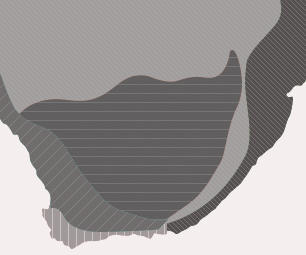Chloris virgata
Chloris virgata Sw.
Family: Poaceae
Common names: blue grass, feather finger grass, feathered chloris, hay grass, old land grass, sweet grass, white grass (Eng.); blougras, hooigras, katstertgras, klosgras, klossiesgras, kwasgras, oulandegras, paardgras, perdegras, spinnekopgras, witgras, witpluimchloris, witpluimgras, wollerigegras (Afr.); amafusine, umadolwana (isiZulu); sehabane (Sesotho); umadolwana (isiXhosa)
Introduction
Chloris virgata is a pioneer grass that grows on bare ground and is used as pasture and hay grass, commonly known as feather finger grass and distinguishable by its blue-green leaves and pale feathery panicles.

Description
Description
Chloris virgata is a tufted annual or sometimes perennial, growing up to 300–750 mm high. It sometimes forms tufts and may spread through stolons. The leaf ligule is in the form of a membrane with fine hairs, there are no hairs on the surface of a leaf sheath. Leaf blade is 100–300 × 2–6 mm, tapering to a fine point at the apex. Inflorescence a digitate and the branches all grow from the same side of the plant and look like spikes consisting of 7–15 racemes, 20–80 mm long, green to straw-coloured, silky-feathery. The spikelets are uniform; mature spikelets turn black later in the season. Spikelet 3.0–4.5 mm long, 3- rarely 2-flowered. Glumes unequal; lower glume 1.5–2.5 mm long; upper glume 2.5–4.5 mm long; lowest lemma 2.5–4.0 mm long, obliquely obovate, hairs along margins, keel and flanks, apex with a crown of spreading hairs 1.5–4.0 mm long, awn 5–15 mm long; second lemma 2.0–2.5 mm long, oblong, glabrous, awn 5–12 mm long; third lemma an awnless, clavate scale 0.5–1.2 mm long. The seed-heads are initially greenish brown and spreading or drooping in nature. Chloris virgata flowers in hot summers, from December to June.

Conservation Status
Status
In the Red List of South African plants, Chloris virgata has been assessed as Least Concern (LC). This grass is not threatened and is regarded as an environmental weed in cultivated lands, but is easily controlled.
Distribution and habitat
Distribution description
Chloris virgata is native to warmer climates; it is a widespread grass species that grows northwards to tropical Africa and worldwide in the tropics. In South Africa, Chloris virgata is dominant and occurs in Limpopo, North West, Gauteng, Mpumalanga, Free State, KwaZulu-Natal and the Northern, Western and Eastern Cape Provinces. It also occurs in Namibia, Botswana, Eswatini (formerly Swaziland), and Lesotho.
This is a hardy grass that can grow in many types of habitat, mostly in disturbed areas such as roadsides and cultivated farmland. It grows in a variety of soil types, even common in clay, sandy, and dry soil. It can also be seen at the edge of seasonal pans.

Derivation of name and historical aspects
History
The genus Chloris is named after the Greek goddess of flowers. The species name virgata is from Latin and means ‘twiggy’ or ‘wand-like’. Its common names, feather finger grass, feathery Rhodes-grass and feather windmill grass refer to its feathery flower spikelets.
In the 1960s, Chloris virgata was promoted in Africa and India as an ideal grass for revegetating uncovered rangelands and highly disturbed areas in saline and alkaline soils.
The genus Chloris has ± 55 species, occurring in tropical and warm temperate regions; 8 species in southern Africa where they are widespread.
Ecology
Ecology
Chloris virgata is primarily cross-pollinated, but it is also self-compatible. It is mostly wind-pollinated. Chloris virgata spreads by seed and vegetatively by stolons. It produces abundant seeds that are easily dispersed by wind and water and as seed contaminants in hay and sticking to animal fur. Livestock movements can also spread seeds and stolons. Each matured Chloris virgata grass can produce up to 6 000 seeds and because this can be done without cross pollination, a small population can grow and spread. The seeds are small, light in weight, with a triangular shape, and are easily shed from the heads making them easily dispersed by wind and water. They can be transported 13 m from the mother plant by moderate wind. Because of the fine hair on the grass seeds, they have the ability to disperse in the agricultural system by attaching to animal fur. Furthermore, they have been identified as a host for aphids.
Uses
Use
This is a well-known grass in the maize-producing parts of South Africa. It is a valuable grazing grass in the more arid parts, where few palatable perennials occur. The spikelets sometimes cling to the wool of sheep. This grass can also be used to resow batches. Chloris virgata is used as revegetation, fodder, and forage grass. It is also used for reseeding uncovered rangeland in highly disturbed areas in arid and semi-arid regions.

Growing Chloris virgata
Grow
Chloris virgata grows in many types of habitat, in dry and moist habitats from sea level to 2 500 m in elevation. This grass prefers heavy soils but has a wide soil range including saline, alkaline, and dark clay soils. It grows from tropical to temperate areas with hot summers. The mean annual rainfall requirement in dry areas ranges from 500 mm to 750 mm, but it is also adapted to arid environments where the minimum rainfall is about 375 mm. The grass should grow up to about half a meter in maximum height, sometimes forming tufts and may or may not spread through stolons. The inflorescence is an array of 4 to 20 fingerlike branches up to 10 centimeters long. Each branch contains approximately 10 spikelets per centimeter, and each spikelet also has 1 fertile floret and 1 or 2, sterile florets. Chloris virgata has rapid germination at a low temperature of about 2.1 to 3.0ºC, therefore, the seeds can germinate and emerge under field conditions after rainfall events in spring, summer, and autumn. Heat also plays a major role in germination and acts as a signal triggering the germination of seeds in this grass. It has a short period to maturity, requiring 300 and 1 200 cadmium from seedlings emergence to tillering (the production of lateral shoots by grass from the base of the stem) and mature seed stages, and high fertility. The establishment of this small-seeded grass is stimulated by light and seedlings emergence is high for seeds present on the soil surface, but declined considerably for seeds buried at 1, 2, and 5 cm depth. Seeds are dormant for about 2 months after maturity. However, seeds buried at 5 cm depth should remain viable for more than 14 months, whereas seeds on the soil surface lose viability after 12 months. Under field conditions, sown seed in the soil persisted longer than those left on the soil surface, and low spring-summer rainfall increase seed persistence. Furthermore, Chloris virgata growth and development are influenced by the time of emergence. The highest germination rates and seedlings weights both occur at typical and high precipitation levels. Different precipitation regimes affect the reproductive strategy of Chloris virgata. This grass does not benefit from low precipitation, whereas typical and high precipitation will improve seed traits and offspring strength of this species. Significant positive correlations between seed mass and non-seed mass in Chloris virgata in response to precipitation regimes is largely allometric (size dependent), as is a significant negative correlation between seed size and seed number at low precipitation.
References
- Atlas of living Australia Database. 2020. Species profile: Chloris virgata. Retrieved from https://bie.ala.org.au/species/http://id.biodiversity.org.au/node/apni/2899120 on 23-02-2021.
- Boutsalis, P., Preston, C. & Gill, G. 2017. Growth, development, and seed biology of feather fingergrass (Chloris virgata) in southern Australia. Weed Science 65(3), pp. 413–425.
- CABI, Invasive Species Compendium. Datasheet: Chloris virgata. https://www.cabi.org/isc/datasheet/109594 Accessed on 11 Feb 2021.
- Fernando, N., Humphries, T., Florentine, S.K. & Chauhan, B.S. 2016. Factors affecting seed germination of feather fingergrass (Chloris virgata). Weed Science 64(4), pp. 605–612.
- Fish, L. & Victor, J.E. 2005. Chloris virgata Sw. National Assessment: Red List of South African plants version 2017.1. Accessed on 2021/02/12.
- Fish, L., Mashau, A.C., Moeaha, M.J. & Nembudani, M.T. 2015. Identification guide to southern African grasses. Strelitzia 36: 271–276. South African National Biodiversity Institute, Pretoria.
- Leistner, O.A. (ed.). 2000. Seed plants of southern Africa: families and genera. Strelitzia 10. National Botanical Institute, Pretoria.
- Van Oudtshoorn, F. 1999. Guide to the grasses of southern Africa. Briza Publications, Pretoria.
- Weeds of Australia, Queensland Government fact sheet: Chloris virgata. https://keyserver.lucidcentral.org/weeds/data/media/Html/chloris_virgata.htm. Accessed 17 Feb. 2021.
- Ying, W., Chunxia, W., Jukui, Z. & Chunqing, W. 2018. Data from: the reproductive strategy in a Chloris virgata population in response to precipitation regimes. Dryad Digital Repository.
Credits
Shirinda Creselda Nyeleti and Aluoneswi Caroline Mashau
National Herbarium (PRE), Pretoria
June 2021
Ackowledgements: some images by Dr Marinda Koekemoer.
Plant Attributes:
Plant Type: Grass
SA Distribution: Eastern Cape, Free State, Gauteng, KwaZulu-Natal, Limpopo, Mpumalanga, North West, Northern Cape, Western Cape
Soil type: Sandy, Clay, Loam, Brack/saline, Metal-rich
Flowering season: Early Summer, Late Summer
PH: Alkaline, Neutral
Flower colour: Brown, Green, Red
Aspect: Full Sun
Gardening skill: Easy
Special Features:
Horticultural zones











Rate this article
Article well written and informative
Rate this plant
Is this an interesting plant?
Login to add your Comment
Back to topNot registered yet? Click here to register.